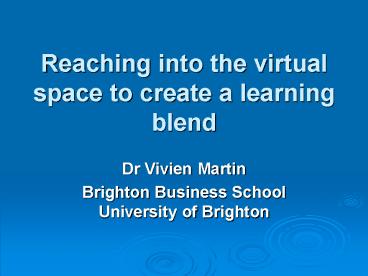Reaching into the virtual space to create a learning blend - PowerPoint PPT Presentation
1 / 11
Title:
Reaching into the virtual space to create a learning blend
Description:
Title: Blended Learning to increase flexibility in initial police training and development Author: Vivien Martin Last modified by: jb229 Created Date – PowerPoint PPT presentation
Number of Views:76
Avg rating:3.0/5.0
Title: Reaching into the virtual space to create a learning blend
1
Reaching into the virtual space to create a
learning blend
- Dr Vivien Martin
- Brighton Business School University of Brighton
2
The existing course
- a new area of work for the university
- a national change in initial police training to
increase links with communities - 200 300 student officers in four intakes each
year - learning on 3 university campuses, in 5 police
divisions, in 100 community places - 120 police tutors
- delivered face-to-face by former police trainers
now HE associate lecturers.
3
Why blended learning?
- there is an existing face to face course
- flexibility is needed for wider inclusion to
- enable part-time study,
- accommodate different levels of prior study,
- respond to slower and quicker learning,
- enable dipping in and out,
- access to HE for experienced police officers,
- support continuing professional development.
4
Blended learning pathways
- blended learning pathways will include
- face to face learning with existing course,
- e-learning in individual study time,
- reflective experiential learning,
- personal tuition (to plan and monitor),
- access to e-library and uni intranet,
- all student services available to full-time
students.
5
The course includes
- Classroom and on the job tuition
- written assignments at HE first year level
- learning from reflection on experience
- engagement in policing in communities
- achievement of National Occupational Standards
for initial policing - award of Foundation Certificate
- first post as a police officer
- progression routes to an honours degree.
6
Developing the Blend
- successful face-to-face course as model
- teaching materials exist (paper-based,
interactive/role play/group, equipment for
hands-on skills) - confident use of intra and internet
- very little e-learning material
- teaching staff are not experienced or confident
with e-learning - this is training and development for a practical
interpersonal role.
7
What will the blend include?
- individual flexible learning pathways
- mix of e-learning with
- personal tuition to plan and support
- accreditation of prior learning
- managed placement experience
- tuition and some face-to-face group activity
- learning from reflection on experience
- range of assessment methods (e-tests, written
assignments, oral discussion, performance) - the same learning outcomes and accreditation as
the existing course.
8
Development of e-learning elements
- modules same content, learning time and
assessment as in face-to-face course - content and approach drawn from and shaped by
course team - e-learning materials development by specialist
team - wide collaboration to develop, approve and test
- all partners share development of e-tutors
- staff development to understand and plan blended
learning pathways.
9
Development costs and budgets
- staffing materials development (authoring,
scripting, audio/video production and project
management) - staff development to plan use of pathway blends
- staff development to support e-learning
- co-ordination meetings (although collaboration
has reduced some costs - compliance with other/existing systems.
10
Delivery costs and budgets
- balance of tutor/study time
- potential use of intranets, web, DVDs and CDROMs
for e-learning - other materials, tuition and managed experience
- registration and assessment
- study time and impact on workplace
- hardware and technical support.
11
Initial issues and learning
- estimates of time much too short
- delays from need to consult and collaborate
rather than in technical process - difficult to develop learning experiences similar
to current course - different expectations of quality in
developmental stages (messy scripts) - need to manage constructive criticism
- potential use of available existing resources
- constant need to balance costs, time and quality.
















![NOTE: To appreciate this presentation [and insure that it is not a mess], you need Microsoft fonts: PowerPoint PPT Presentation](https://s3.amazonaws.com/images.powershow.com/6387942.th0.jpg?_=20200719041)














